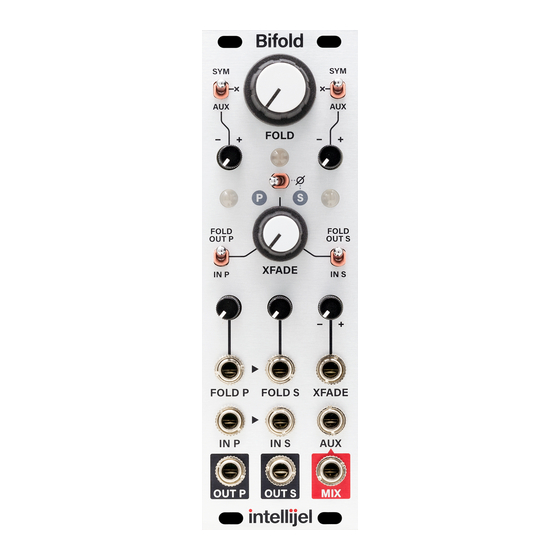
Table of Contents
Advertisement
Quick Links
Advertisement
Table of Contents

Summary of Contents for Intellijel Bifold
- Page 1 Bifold Manual Bifold Dual Channel Wavefolder Manual Revision: 2020.08.30...
-
Page 2: Table Of Contents
Bifold Manual Table of Contents Compliance Installation Installing Your Module Overview Bifold Front Panel Controls Inputs and Outputs Usage Scenarios Crossfading Folded and Unfolded Waveforms Stereo Folding Ring Modulation Amplitude Modulation Random Noise Generation Technical Specifications ... -
Page 3: Compliance
(2) this device must accept any interference received, including interference that may cause undesired operation. Changes or modifications not expressly approved by Intellijel Designs, Inc. could void the user’s authority to operate the equipment. Any digital equipment has been tested and found to comply with the limits for a Class A digital device, pursuant to part 15 of the FCC Rules. -
Page 4: Installation
Installation Intellijel Eurorack modules are designed to be used with a Eurorack-compatible case and power supply. We recommend you use Intellijel cases and power supplies. Before installing a new module in your case, you must ensure your power supply has a free power header and sufficient available capacity to power the module: ●... -
Page 5: Installing Your Module
Eurorack case. Ensure the red stripe on the cable lines up with the -12V pins on the bus board. On Intellijel power supplies the pins are labelled with the label “-12V” and a thick white stripe. Sometimes the connectors are shrouded, ensuring the cable can only be oriented in one direction. - Page 6 Bifold Manual Once connected, the cabling between the module and power supply should resemble the picture below: Before reconnecting power and turning on your modular system, double check that the ribbon cable is fully seated on both ends and that all the pins are correctly aligned.
-
Page 7: Overview
Overview Bifold is a dual channel wavefolder, where one channel (the P channel) has a sonic characteristic inspired by the Buchla-style P arallel “deadband” folding circuit, while the other channel (the S channel) is more characteristic of a Serge-type S erial folding circuit. -
Page 8: Bifold Front Panel
Bifold Manual Bifold Front Panel Controls FOLD knob - This knob sets the initial amount of wave folding applied to both the IN P (parallel) and IN S (serial) folders and sent to the OUT P , OUT S and MIX outputs. - Page 9 Bifold Manual feeding equal signals into the MIX output at the noon position. When fully clockwise, only the S erial circuity is heard at the MIX out. You can choose whether to feed the crossfader with either channel’s unfolded (dry) signal ( IN P...
- Page 10 Bifold Manual SYM-X-AUX switch for Serial Folder - The position of this switch affects the signal being fed into the S erial folder. Specifically: SYM - When set to SYM (up position) a DC offset of up to ±5V is added to the IN S...
- Page 11 Bifold Manual SYM-AUX attenuverter for Serial Folder - Depending on the setting of the S erial folder’s SYM-X-AUX switch the knob either attenuverts a 5V DC offset voltage (when set to the “SYM” position) or it attenuverts the AUX input voltage (when set to the “AUX”...
- Page 12 Bifold Manual XFADE S input selector switch - The position of this switch selects the signal source that feeds into the crossfader’s S -side input (clockwise rotation of the XFADE knob), which is then mixed with the selected P -side input and sent through to the MIX output.
- Page 13 FOLD P voltage is used to control folding. NOTE: If nothing is plugged into the FOLD P jack, then Bifold internally normals +5V to that jack, meaning this knob acts as a 0V (counterclockwise) to +5V (clockwise) attenuator. IMPORTANT: If the FOLD...
-
Page 14: Inputs And Outputs
Bifold Manual Inputs and Outputs OUT P - Output of the P arallel wavefolder circuit. OUT S - Output of the S erial wavefolder circuit. MIX OUT - Output of the mixed (crossfaded) P arallel and S erial folder circuits. - Page 15 SYM-AUX attenuverter [5, 6] If nothing is patched into the AUX input, then Bifold’s output feeds the AUX input. FOLD P CV IN - This input accepts a ±10V control voltage for externally controlling the amount of folding applied to the P arallel wavefolder.
- Page 16 Bifold Manual the FOLD knob is higher than its minimum position, then negative voltages applied to FOLD S decrease the folding, and positive voltages increase it. If nothing is plugged into either this jack or the FOLD P jack, then +5V is internally applied, which can be attenuated...
-
Page 17: Usage Scenarios
Crossfading Folded and Unfolded Waveforms You can use Bifold to mix together two different waveforms from a single (or multiple) oscillators — one folded and one unfolded — then crossfade between them to create complex and evolving waveforms. -
Page 18: Stereo Folding
Bifold Manual Stereo Folding Some very interesting stereo effects can be achieved by sending OUT P to one stereo channel, and the OUT S jack to the other. For example: 1. Patch a waveform into the IN P jack and leave the IN S jack unpatched. -
Page 19: Ring Modulation
XFADE input, and sent to the MIX output. Amplitude Modulation You can also use the Bifold to create Amplitude Modulation (AM). To do so: 1. Follow steps 1-6 in the Ring Modulation description, above. 2. Plug a dummy cable into IN S 3. -
Page 20: Random Noise Generation
Bifold Manual Random Noise Generation Use the module’s built-in feedback path to create all manner of strange and chaotic blips, hisses and noise bursts. To do so: 1. Unpatch everything except the MIX output. 2. Set both the Parallel and Serial SYM-X-AUX switches [3, 4] to the AUX (bottom) position.






Need help?
Do you have a question about the Bifold and is the answer not in the manual?
Questions and answers